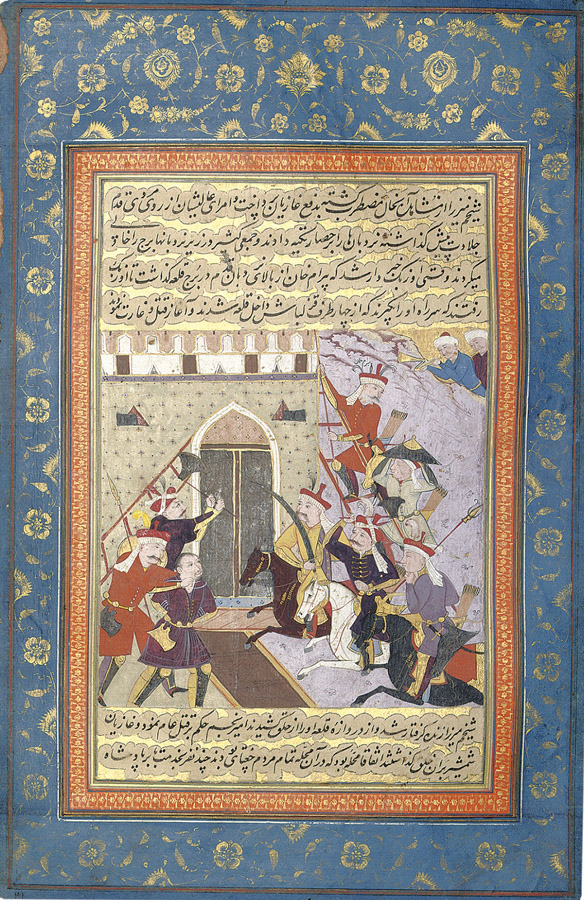Location: present whereabouts unknown
Mount: blue heightened with gold 35.8 x 23.5 cm; orange collar.
Written surface: 23.8 (scaled) x 15.2 cm;
Painting: 14.9 x 15.2 cm.
Text references: J.K., p.429 line 12 to p.430 line 3.
See also Savory, SA_1979, pp. 63-66 for this event in the History of Shah ʿĀbbās.
Date of this event: 918/Autumn 1512.
Following Esmāʿil's defeat of Šāhibeg Khan in December of 1510, a peace treaty was concluded that left Transoxiana in Uzbeg hands provided they pledged not to attack Khorasan or any other Safavid province. The treaty was short lived however, and once Esmāʿil had departed, the Uzbegs again started raiding Safavid territory. Moḥammad Bābor Mirzā, an ally of the Safavids and founder of the Mughal dynasty, requested support from Esmāʿil to invade Transoxiana. After some initial defeats, the Uzbeg sultans abandoned Samarkand and withdrew in the direction of Turkestan. After the qezelbāš emirs had left however, the Uzbegs returned and overwhelmed Bābor, who once again requested Safavid aid. Esmāʿil, upon hearing of these events dispatched Emir Najm-e S̱āni, the vakil-e divān-e aʿlā, to set the affairs of Khorasan in order. Emir Najm decided to invade Transoxiana, and together with Ḥoseyn Beg Lāla the governor of Herat, and Beyrām Khan Qarāmānlu, the governor of Balkh, advanced across the Oxus, joined up with Bābor Mirzā, and captured first the fort at Ḵozār, and then the fort of Qarši.
The painting
illustrates the battle for the fort at Qarši. Safavid troops can be seen besiegingt the gate with one prisoner already in tow. Beyrām Khan Qarāmānlu, in the upper right is scaling a ladder leading a detachment to the top of the fortress wall. An inscription, just above his head reads beyrām ḵān. There are three mounted qezelbāš in the lower right before the castle door; the center one, dressed in purple, might possibly be identified as either Emir Najm or Ḥoseyn Beg Lāla. The fort is simply portrayed as a solid beige wall with a door, and crenelations at the top, with its back set into a steep rocky hillside.
Painting references:
Sothebys London, 20 November 1986 Lot 201 (not illustrated)
Christie's London, 17 April 2007, Lot 246
Photo courtesy of Christie's. © Christie's Images Ltd. 2012
Robert Eng
Last Updated: August 1, 2011 | Originally published: August 1, 2011
